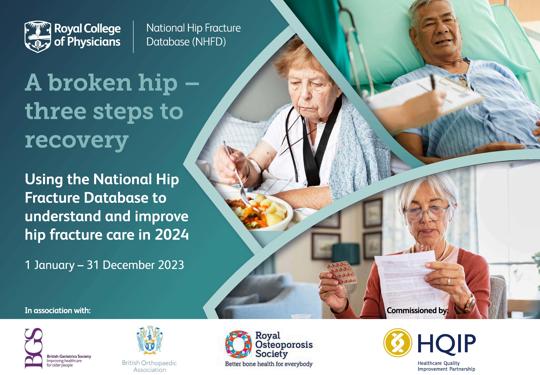A broken hip - three steps to recovery.
The National Hip Fracture Database’s 2024 report, A broken hip - three steps to recovery, has been published today and aims to provide readers with a simple interactive guide to all our data and resources, as we seek to monitor and improve the experience of people at three key stages in their recovery from hip fracture.
Every year, over 70,000 people in England, Wales and Northern Ireland will fall and sustain a hip fracture. Most people now survive, so it is not enough to measure quality of care by examining mortality figures alone. This report shows how the National Hip Fracture Database captures patients’ experience and helps to answer questions about 3 key steps in recovery from this injury. The report aims to provide readers with a simple guide to all these data and resources by describing the care that hip fracture patients should receive on their journey to recovery:
- as they first present with a new hip fracture
- as surgery allows them to get out of bed again
- through rehabilitation until they are back in their home.
This year’s report celebrates the maturity of the brilliant NHFD website as it looks at three key stages in people’s recovery from a hip fracture. The report provides simple advice and short videos so clinicians, health service managers and members of the public can easily use the live information on the NHFD website to understand and improve the care provided to people with this injury.
Antony Johansen, NHFD orthogeriatrician clinical lead
As we celebrate the release of the 2024 National Hip Fracture Database report, it is timely to reflect upon this as period the database has seen its one millionth patient entered. This landmark represents a considerable amount of knowledge gained in how best to look after older patients with a broken hip or femur. From such a mature and validated database it could be easy to maintain a status quo in reporting and assessing metrics of care, however this would be a waste and would not help us in moving forward to help improve how our patients experience care after breaking a hip.
In this report we focus on key phases of care and despite being a surgeon, I feel that the non-surgical areas remain the most impactful domains of care where improvements can still be made. This report lays out clearly where care is still failing across countries and within individual units. Time the patient spends 'in the wrong place' is a particular and growing focus of attention that is highlighted this year.
This is only one of many significant opportunities for reflection and improvement of care as we move into 2025 and we look forward to continuing the positive impact into the coming year.
Will Eardley, NHFD orthopaedic surgery clinical lead
NHS England and Welsh Government should use NHFD data to monitor hospitals’ delivery of three key stages of care:
- To ensure that hospitals are ready for the people they know will present each day, so patients receive each step of their care at the right place at the right time.
- To ensure that all hospitals provide both prompt surgery and optimal peri-operative care so patients can start getting back on their feet as soon as possible.
- To ensure rehabilitation and recovery is planned and started early, and continues beyond the hospital with measures to prevent another fracture.
NHS England and the Welsh Government need to address wider inequalities and inequities in patient care:
- By agreeing a standardised approach to the collection of ethnicity data across all patients’ pathways and provider organisations.
- By ensuring that people with other injuries benefit from the improvements that have been pioneered among those with hip fracture.





